B.E. Smith Team | November 13, 2017
EXECUTIVE COMPENSATION: LEADERSHIP TRENDS AND STRATEGIES FOR ORGANIZATIONAL SUCCESS
Executive compensation directly and indirectly impacts many aspects of talent management, employee engagement, and organizational success. As such it is a topic of great interest to healthcare professionals and organizations alike. For more than 40 years, B.E. Smith has actively monitored executive compensation trends and offered insights and advice to client organizations and candidates. This year, B.E. Smith conducted its first executive compensation survey of more than 250 healthcare leaders. The Executive Compensation Intelligence Report summarizes key findings and provides insights into current data, challenges, and strategies. The report delivers actionable intelligence which is highly relevant to current and future healthcare leaders.
DEMOGRAPHIC PROFILE
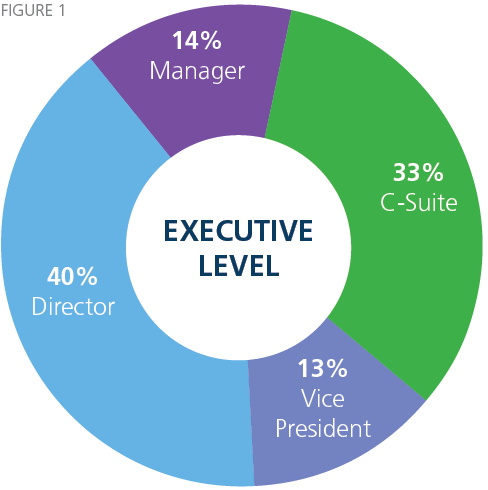 This year’s executive compensation survey consisted of the full spectrum of healthcare management, with particular emphasis on both C-suite and director levels. Figure 1 displays the distribution. More than 52% work in an independent hospital or health system, with the remainder coming from a variety of outpatient and post-acute healthcare settings.
This year’s executive compensation survey consisted of the full spectrum of healthcare management, with particular emphasis on both C-suite and director levels. Figure 1 displays the distribution. More than 52% work in an independent hospital or health system, with the remainder coming from a variety of outpatient and post-acute healthcare settings.
Additionally, 26% of survey respondents work in organizations generating revenue north of $1 billion, while 27% are employed in organizations generating under $100 million. The remaining respondents fell between those revenue levels with 18% in organizations bringing in up to $299 million, 13% in organizations generating up to $499 million, and 16% in organizations with revenue up to $999 million.
CURRENT COMPENSATION SNAPSHOT
B.E. Smith’s executive compensation survey asked healthcare leaders directly about total compensation – inclusive of cash, non-cash, and deferred amounts – to ascertain current levels as a way to inform benchmarking and other analyses. The largest group, 71% of respondents, self-reported a compensation level between $100,000 to $299,000. However, levels did vary with 12% of respondents reporting total compensation packages over $300,000 and 17% reporting compensation below $100,000. (See Figure 2)
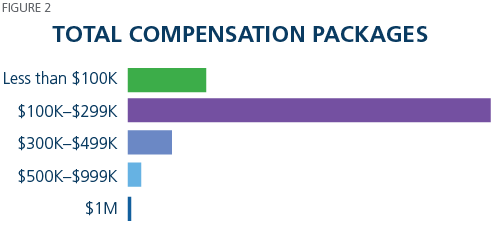 A survey recently published by Modern Healthcare offers additional insight on executive compensation. The survey found median cash compensation for CEOs of individual hospitals owned by a system was $467,000. Median cash compensation for CEOs of healthcare systems was much higher at $1.1 million. (1) Willis Towers Watson Data Services pegged compensation for CEOs across healthcare at $796,000 in 2016.(2) Compensation for other key C-suite titles ranged widely by source. Modern Healthcare’s report found executive compensation varied from $240,000 to $411,000 at the hospital level and $287,000 to $700,000 at the system level in the data. While results from the Willis Towers Watson Data Services survey showed a range from $256,000 for top HR executives up to $418,000 for CFOs.
A survey recently published by Modern Healthcare offers additional insight on executive compensation. The survey found median cash compensation for CEOs of individual hospitals owned by a system was $467,000. Median cash compensation for CEOs of healthcare systems was much higher at $1.1 million. (1) Willis Towers Watson Data Services pegged compensation for CEOs across healthcare at $796,000 in 2016.(2) Compensation for other key C-suite titles ranged widely by source. Modern Healthcare’s report found executive compensation varied from $240,000 to $411,000 at the hospital level and $287,000 to $700,000 at the system level in the data. While results from the Willis Towers Watson Data Services survey showed a range from $256,000 for top HR executives up to $418,000 for CFOs.
DIRECTION OF COMPENSATION LEVELS
As financial headwinds produce tighter operating margins for many hospitals, it is perhaps little surprise that 51% of survey respondents indicated their compensation was the same or lower than last year. The median decrease was 15%. Those experiencing an increase averaged 4%, a healthy figure in the current economic environment and likely driven by healthcare’s highly competitive labor market. The increase is in line with the median rise of 6% that Modern Healthcare calculated for 36 executive positions in healthcare systems, and the 3.1% increase for key executives in individual hospitals.
New roles and positions have emerged recently in response to the growing need to emphasize strategic change, clinical performance, and technology. Consistent with this trend, Willis Towers Watson Data Services isolated three positions whose 12%-16% compensation growth last year stands out as significant growth:
- Top Strategic Planning Executives
- Top Medical Informatics Executives
- Top Clinical Effectiveness Executives
AT RISK INCENTIVES
The industry’s shift to value-based care is resulting in healthcare organizations assuming increasing financial risk as reimbursement models change from fee-for-service to pay-for-performance. One goal of this year’s survey was to identify if this shift was impacting executive compensation. Surprisingly only 62% of survey respondents identified a portion of their compensation at-risk for value-based activities. The percentage of compensation at risk varied, with most healthcare executives acknowledging between 12% and 19% of compensation tied to value-based activities. (See Figure 3)
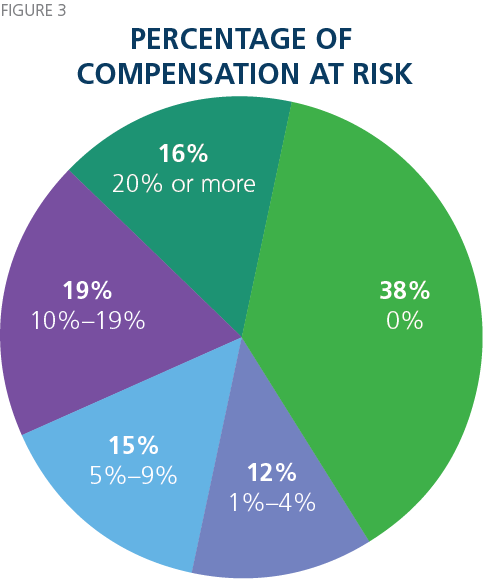 Organizations are turning to several incentive metrics to track the challenging balancing act of achieving quality care objectives while maintaining financial health. Survey respondents mentioned specific targets connected to staff engagement, physician engagement, and population health management. However, the leading targets identified to serve as a basis for executive incentive payments include:
Organizations are turning to several incentive metrics to track the challenging balancing act of achieving quality care objectives while maintaining financial health. Survey respondents mentioned specific targets connected to staff engagement, physician engagement, and population health management. However, the leading targets identified to serve as a basis for executive incentive payments include:
- Operating margin/cash flow – 23%
- Growth – 19%
- Patient engagement/satisfaction – 17%
- Clinical performance – 17%
SATISFACTION WITH COMPENSATION
B.E. Smith’s survey found executives had a decidedly mixed view of the compensation environment. When asked for their satisfaction on executive compensation, 48% of survey respondents said they were satisfied with current pay, compared to 30% unsatisfied and 22% neutral.
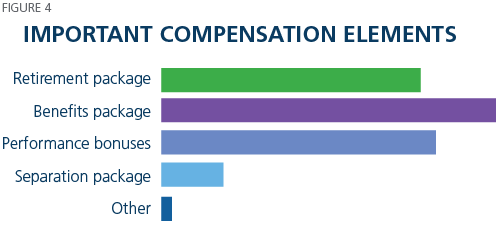 The survey revealed several motivation factors which organizations can utilize to fine-tune the compensation mix. Respondents identified the elements of compensation most important to them, other than salary. The results (see Figure 4) mirror previous surveys, with benefits, retirement packages, and bonuses topping the list.
The survey revealed several motivation factors which organizations can utilize to fine-tune the compensation mix. Respondents identified the elements of compensation most important to them, other than salary. The results (see Figure 4) mirror previous surveys, with benefits, retirement packages, and bonuses topping the list.
COMPENSATION STRATEGIES AND TRENDS
STRATEGIC ALIGNMENT ISSUES
Compensation is most effective when it is aligned closely with an organization’s strategic goals. The B.E. Smith survey explored this issue in detail. As organizations try to address rapid and difficult change, they appear to be experiencing misalignment in regards to compensation. Almost 60% of respondents stated their compensation and overall strategies are seriously or slightly misaligned. Contrary, only 40% suggested compensation was aligned. The finding is significantly higher than similar surveys sponsored by B.E. Smith, which have shown an upward trend for the past two years.
Still, organizations are making progress in this area as evident by the 76% of respondents who said compensation was “slightly misaligned” or “pretty well aligned.” Additionally adjustments can help organizations improve satisfaction among executives and staff.
A majority of executives also identify a need for change in alignment of compensation with financial health care quality strategies. (See Figure 5) Nearly 50% of executives said their organization needed to address financial strategies, while 40% of executives said work needed to be done to better align compensation with patient care. The survey did provide a positive outlook as 19% of executives said their organization had already improved the alignment with financial strategies, and 26% identified progress towards patient care outcomes.

SUPPORT FOR VALUE-BASED CARE
Adjusting compensation strategies towards value-based care remains a work in progress. According to the survey, 55% of leaders said their organization has not modified compensation packages to align specifically with value-based care objectives. Still, there is reason for optimism as 16% of respondents said their organization has already modified compensation and 20% anticipate making modifications.
Value-based care places a premium on collaboration and team-building. According to surveyed healthcare executives, the top four team incentives modified to promote value-based care were:
- Patient engagement – 34%
- Clinical performance – 27%
- Staff engagement – 12%
- Population health management – 12%
For hospitals, both patient engagement and clinical performance require external measurements for reimbursement, making the incentives directly relevant for teams. In addition, it is surprising survey respondents didn’t rank population health management higher given the industry’s focus on this care strategy. Particularly when you consider B.E. Smith’s Intelligence Report earlier this year revealed 38% of organizations do not have a population health management strategy in place or are still developing one. The survey also found 30% of organizations are still implementing a strategy. The surveys appear to show that incentives are not being instituted in advance or in conjunction with programs.
EXECUTIVE COMPENSATION CHALLENGES
As healthcare leaders grapple with the best approaches to managing change and shepherding transformation, it is instructive to understand which compensation challenges are most urgent in this environment. Figure 6 shows a significant range of answers in this year’s survey. Balancing quality of care and financial goals was a challenge executives highlighted throughout the survey. However, utilizing compensation to effectively attract and retain executive talent were both clear concerns for healthcare leadership.

COMPENSATION AND RETENTION
It should come as no surprise that executive compensation plays a critical role in retention of experienced leaders. However, contrary to popular opinion, it is not the primary driver. B.E. Smith research indicates work-life balance most heavily influences retention, with compensation ranking second. (See Figure 7) B.E. Smith counsels healthcare organizations regularly regarding best practices for recruitment and retention. Implementing strategies focused on work-life balance, compensation, culture, and development will improve employee retention and satisfaction. In turn, these strategies will effectively combat increasing leadership turnover in today’s competitive healthcare labor market.
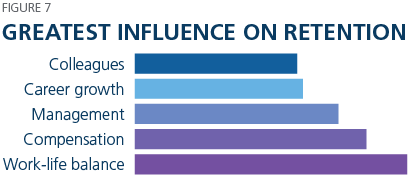 In line with surveys conducted in past years, healthcare leaders in this latest survey heavily endorsed the need to enhance their organizational compensation structures to foster retention. Nearly 45% of respondents said their organization’s compensation structure needed “major enhancement,” while 43% indicated a minor change is required. Such levels suggest leaders perceive a significant gap in attaining the kind of engagement that sustains strong retention rates.
In line with surveys conducted in past years, healthcare leaders in this latest survey heavily endorsed the need to enhance their organizational compensation structures to foster retention. Nearly 45% of respondents said their organization’s compensation structure needed “major enhancement,” while 43% indicated a minor change is required. Such levels suggest leaders perceive a significant gap in attaining the kind of engagement that sustains strong retention rates.
COMPENSATION AND RECRUITMENT
Healthcare executives consistently listed “finding quality talent” as their major concern in leadership recruiting. It is a complex challenge and a primary reason healthcare organizations turn to B.E. Smith for assistances with their leadership needs. Adding to the complexity is the need to not just find quality talent, but talent with the array of skills needed to succeed over the next five years. Respondents in B.E. Smith’s compensation survey listed the following four competencies as the most important for CEOs.
- Optimizing results along the care continuum – 18%
- Mergers, acquisitions, and partnerships experience – 16%
- Physician alignment experience – 17%
- Cost containment abilities – 12%
When asked which competencies were most important for other C-suite executives, the top four skills varied slightly. Cost containment jumped to the top of the list, while value-based purchasing expertise replaced experience leading mergers, acquisitions, and partnerships.
- Cost containment abilities – 17%
- Optimizing results along the care continuum – 18%
- Value-based purchasing expertise – 11%
- Physician alignment experience – 11%
With the recruitment stakes so high, particularly at the senior level, organizations are increasingly examining compensation as an incentive. More than one in four respondents said they previously increased total compensation to recruit executive leaders. The highly competitive talent market today almost ensures that this tactic will increase, placing further cost pressure on hospitals. Indeed, survey participants themselves demonstrated the urgency of the trend, as 75% stated they are currently considering new career opportunities. A nearly equal percentage registered confidence in finding a new position within a year. The findings also reinforce the use of salary in talent recruitment, with compensation ranking second only to brand/culture as the leading factor influencing a decision to join a new organization.
SIGNIFICANT MEASUREMENT CHALLENGES
In addition to the significant focus on recruitment and retention, B.E. Smith’s compensation survey also revealed a set of challenges related to measuring the alignment of compensation with value-based care initiatives and outcomes. Survey respondents reported concerns with several aspects of the measurement side of the equation, including determining the right “goals” and “metrics” to reward pay-for-value tasks. More generally, many healthcare executives identified “accommodating long-term goals in compensation programs” as a primary challenge. This reflects the urgency of current demands as well as the multi-year endeavors needed to implement true value-based care.
CONCLUSION
The 2017 Executive Compensation Intelligence Report offers fresh data for healthcare leaders and planners. The findings illuminate the statistics, challenges, and strategies that characterize the current executive pay environment. Evaluating this information in light of one’s own organization can point to meaningful directions to enhance compensation effectiveness.
RESOURCES
- A. Kacik, “Executive Compensation: C-suite pay raises target transformational leaders,” Modern Healthcare, August 14, 2017.
- Willis Towers Watson Data Services, Health Care Executive and Management Compensation Survey Report, 2016.
Read More